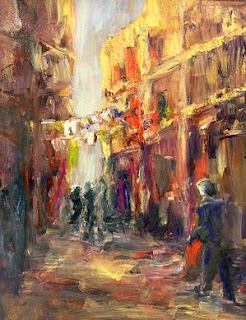A common theme among artists discussing their careers, whether they be full-time or part-time artists, is that people in their lives - parents, friends, sometimes even they themselves - were unenthusiastic about them pursuing an art career.
 |
Looking for Oats by Meg Mackenzie
(Watercolor) |
"
At around 15 years old I discovered art class in school as an elective and fell in love with the different media possibilities, says Gallery member Meg Mackenzie. "But being raised in a military family, my father did not think art would constitute a legitimate living wage. I did not really know what direction I wanted to pursue in life. I tried history, math, Russian language, finance..."
 |
Waiting II by Chica Brunsvold
(Acrylic on Paper) |
“Even as a preschooler I loved to draw - it was my favorite activity,” echos Gallery Member Chica Brunsvold. “My parents encouraged me and actually hired a teacher for me when I was in junior high school. My interest continued through high school where I took painting courses at night at the University of Michigan. I wanted to major in art but my father, a retired linguistics professor at U of MI, was convinced I would not get an education in the Art School and insisted I attend the Lit School there."
Having been born and raised in the Soviet Union, Gallery member Anya Getter had to chose a more practical path to pursue than the tumultuous world of art. While she had dreamed of attending an art school she choose instead to enter the world of Information Technology.
 |
Of Two Element by Anya Getter
(Acrylic) |
These artists all took circuitous routes to get to where they are now - motherhood figured prominently in all of their lives. Mackenzie "meandered through a career as a business manager with a defense contractor," eventually staying home to raise her 2 sons. Brunsvold also did some career meandering, albeit more related to art: she obtained an art degree after her father's death, and worked in both the CIA's and Armed Forces' art shops, eventually leaving to raise her daughter.
For her part, Getter immigrated to the United States, married, established an IT career and added a dynamic duo of twins to her family.
However, what was overriding with all three was that they could not ignore their artistic muses. Brunsvold eventually began taking watercolor classes and after the first course, the instructor said she was quitting and wanted her to teach the class. That meant she had to seriously study to be able to guide her adult students. She took lots of classes and workshops and when her daughter went off to college, she immersed herself in artwork.
 |
Do You See What I See By Chica Brunsvold
(Acrylic) |
When she began, considered herself a realist, but it was during the time of abstract expressionism, so she joined in. Even now she says she begins her paintings as an abstract expressionist, but searches for images, as she's still a realist at heart. "My greatest joy is discovering and developing hidden images, usually fanciful and whimsical in nature. My husband was a patent attorney and got me a trademark on the term Zooillogicals (R). I imagine the term may someday be more valuable than my paintings!"
Getter felt the longing of her creative side wanting to be free and found a way to create that related to being a mother. In the beginning, she began experimenting with imaginative decorations for children's jeans and denim overalls. This practice took off with the help of eBay and other mothers looking for unique outfits for their children. This allowed Getter to review her talents and the directions she wished to go in artistically. In 2009, she began more serious work as painter, exploring methods and techniques that communicated her vision.
 |
A Fine Balance by Anya Getter
(Acrylic on Board) |
Drawn to bright colors and whimsical images, she is often inspired by powerful quotes. "Painting is like a meditation for me," she says. "Even though it can get very frustrating every now and then to the point where I can't bring myself to even go near canvas, eventually I return to that bittersweet process, she says "Because nothing is more rewarding than throwing your emotions and thoughts on canvas and have other people 'get it.'"
Mackenzie had a friend who was starting to teach an acrylic course, which Mackenzie eagerly decided to take for a year. Then in 2000 another friend asked if she would be interested in watercolor classes they could both attend and carpool together. An early passion for horses developed into a successful career painting both traditional and abstract works depicting horses. Her painting "Horse #17" (shown below) just won Best in Show at the monthly juried show "Small Works" at the Art League in Alexandria, VA.
 |
Horse # 17 by Meg Mackenzie
(Mixed Watermedia) |
These artists have all had a winding road to artistic success, but are now selling and showing their work, earning kudos in the form of acceptance into juried exhibitions and awards. Despite early discouragement and delays, when you are truly an artist, you are never deterred.
--Sandi Parker, Gallery Underground Co-Director





































